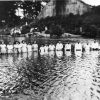calsfoundation@cals.org
Parley P. Pratt (Murder of)
Parley Parker Pratt, an original member of the Quorum of the Twelve Apostles of the Church of Jesus Christ of Latter-day Saints, was murdered in Arkansas in 1857 and buried in the state, despite his wishes to be buried in Utah. The Van Buren (Crawford County) newspaper Arkansas Intelligencer, on May 15, 1857, deemed Pratt “a man of note among the Mormons.” While another notable event involving Mormons in Arkansas—the massacre of Arkansas emigrants four months later at Mountain Meadows, Utah—was formerly linked to Pratt’s murder in Arkansas, more recent inquiry suggests other circumstances may have ignited the violence at Mountain Meadows on September 11, 1857.
Pratt was one of the key figures in the early Church leadership. Pratt’s writings, which include pamphlets, hymns, and an entertaining autobiography, helped define early Mormon theology, and his hymns are still widely sung in congregations. Born in Burlington, New York, in 1807, he preached to the Creek and Cherokee nations as a young missionary, as well as to congregations in Canada, England, California, and the Pacific, and he was the first Latter-day Saint missionary to serve in Chile in South America.
Scarcely known in Arkansas during his lifetime, Pratt was murdered on May 13, 1857, in Crawford County by Hector McLean, the estranged husband of Eleanor McComb McLean, who had become Pratt’s twelfth plural wife. The murder shocked the Latter-day Saint community and became front-page news throughout the nation. Eleanor McLean portrayed Pratt as a martyr who had rescued her from her alcoholic, abusive husband; however, national accounts, unfavorable to the Mormons’ practice of polygamy (discontinued in 1890), reported that Pratt had seduced Eleanor away from her husband.
Pratt and Eleanor McLean had met three years earlier while Pratt was living in San Francisco, California, and presiding over the Church’s Pacific mission. Eleanor embraced Mormon principles and was baptized into the Church with her husband’s consent. In 1855, following a domestic dispute, Hector McLean secretly sent their children from San Francisco to New Orleans, Louisiana, to live with their maternal grandparents, whereupon Eleanor determined to leave him. She then traveled to New Orleans to get her children.
Eleanor and Pratt had decided to meet at Fort Smith (Sebastian County) and travel back to Utah together. Hector McLean heard of their intended rendezvous and beat them to Arkansas, where he filed charges against them and got warrants for their arrests. Hector caught up with Eleanor and Pratt in Indian Territory (present-day Oklahoma) and again took the children away. Hours later, a state marshal arrested Eleanor on a charge of stealing children’s clothing, while a military escort apprehended Pratt. They were first taken to Fort Gibson and then to Van Buren. There, Eleanor was brought before Judge John Ogden, who released her without further charges. Pratt, whose trial was postponed because of public outrage and general hostility, was kept overnight and secretly released early the next day. Hector McLean learned of Pratt’s release and caught up with Pratt on the Zealey Wynn property in Fine Springs (Crawford County), some twelve miles northwest of Van Buren, where he shot and stabbed Pratt.
As he lay dying, Pratt requested that his remains be interred with his family in Utah. For many years, family and descendants attempted to locate and remove his remains from the Wynn Cemetery in Fine Springs—north of Alma (Crawford County)—to the space reserved for him in the family plot in Salt Lake City, Utah. In 2008, the most sophisticated scientific tools available (including ground-penetrating radar) were used to ascertain the location of Pratt’s remains. Despite evidence of a burial, no human remains were found.
Today, exiting Interstate 49 at the Rudy (Crawford County) exit and then turning left at the first road, visitors can find the Pratt grave site in the small Wynn Cemetery. The site is open to the public and is marked by a large granite monument upon which is engraved one of Pratt’s most well-known hymns, “The Morning Breaks.”
For additional information:
Armstrong, Gregory K., Matthew J. Grow, and Dennis J. Siler, eds. Parley P. Pratt and the Making of Mormonism. Norman, OK: Arthur H. Clark Company, 2011.
Givens, Terry L., and Matthew J. Grow. Parley P. Pratt: The Apostle Paul of Mormonism. New York: Oxford University Press, 2011.
Jared Pratt Family Association. http://jared.pratt-family.org/ (accessed October 21, 2021).
Pratt, Parley P., Jr., ed. The Autobiography of Parley P. Pratt: One of the Twelve Apostles of the Church of Jesus Christ of Latter-day Saints, Embracing His Life, Ministry, and Travels, with Extracts, in Prose and Verse, from His Miscellaneous Writings. Arlington, VA: Stratford Books, 2005.
Greg Armstrong
University of Arkansas at Fort Smith
 Louisiana Purchase through Early Statehood, 1803 through 1860
Louisiana Purchase through Early Statehood, 1803 through 1860 Religion
Religion Parley Parker Pratt Monument
Parley Parker Pratt Monument 




Comments
No comments on this entry yet.